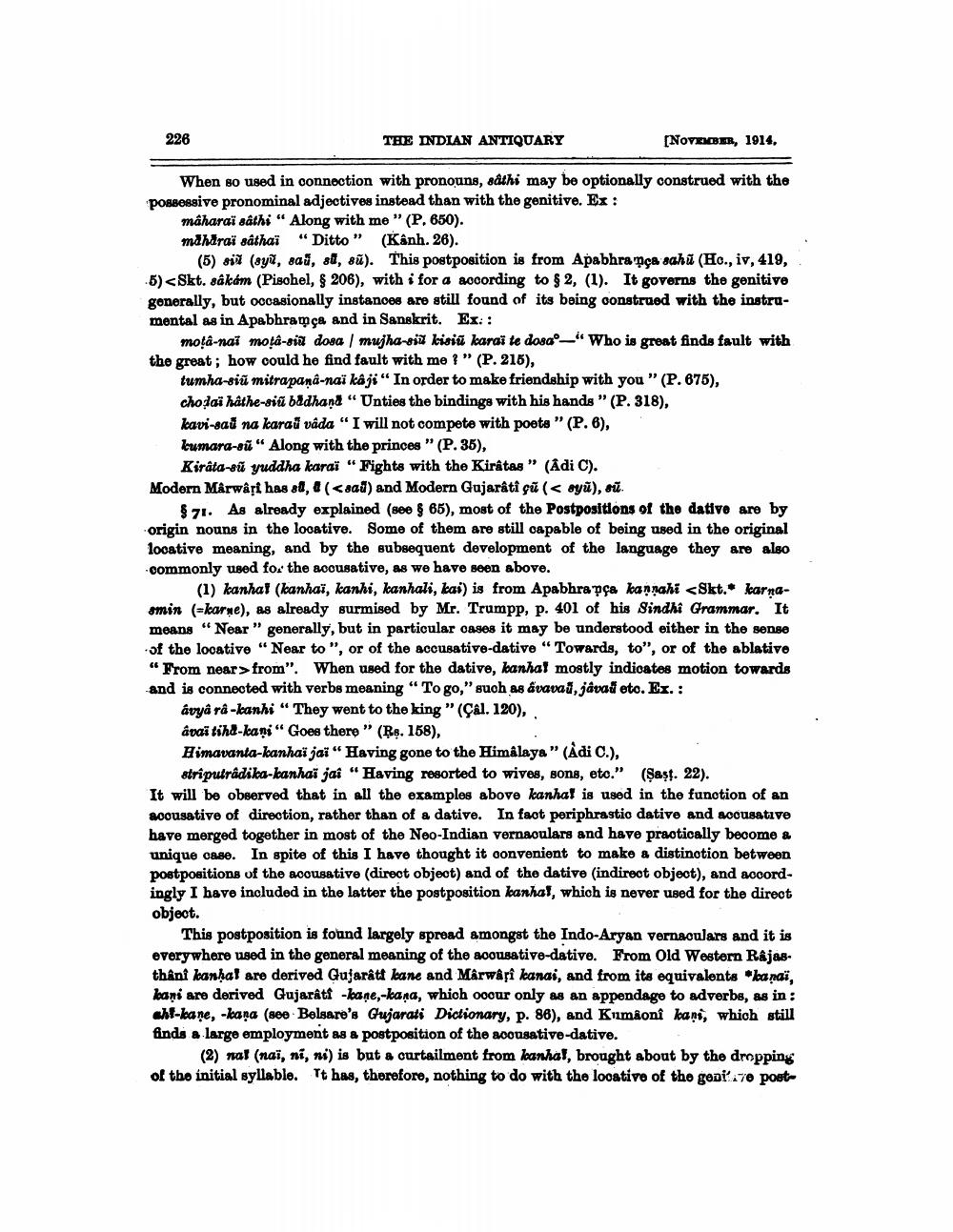________________
226
THE INDIAN ANTIQUARY
[NOV.GER, 1914,
When so used in connection with pronouns, sathi may be optionally construed with the Possessive pronominal adjectives instead than with the genitive. Ex:
maharaï sathi "Along with me" (P. 650). maharai sáthaï "Ditto" (Kanh. 26).
(5) si (syų, sau, si, sū). This postposition is from Apabhrapça sahū (Ho., iv, 419, 5) Skt. sakám (Pischel, $ 206), with i for a according to $ 2, (1). It governs the genitive gonerally, but occasionally instances are still found of its being oonstrued with the instrumental as in Apabhramça and in Sanskrit. Ex::
mota-nai mota-si dosa / mujha-siu kisiū karai te dosao-'Who is great finde fault with the great ; how could he find fault with me?" (P. 216),
tumha-siū mitrapana-naï kaji" In order to make friendship with you " (P. 675), cho lai hathe-siti badhand "Unties the bindings with his hands" (P. 318), kavi-sai na karau váda " I will not compete with poeta" (P. 6), kumara-sū" Along with the princes" (P. 35),
Kirâta-sű yuddha karai "Fights with the Kirâtas” (Adi C). Modern Marwari has sl, 4 ( <sad) and Modern Gujarati cũ(< syű), sū.
$71. As already explained (see $ 65), most of the Postpositions of the dative are by origin nouns in the locative. Some of them are still capable of being used in the original locative meaning, and by the subsequent development of the language they are also commonly used for the socusative, as we have seen above.
(1) kanhal (kanhai, kanhi, kanhali, kai) is from Apabhrapça kannahi sSkt. karnasmin (=karne), as already surmised by Mr. Trumpp, p. 401 of his Sindhi Grammar. It means “Near" generally, but in particular cases it may be understood either in the sense of the locative "Near to ", or of the accusative-dative "Towards, to", or of the ablative "From near>from". When used for the dative, kanhal mostly indicates motion towards and is connected with verbs meaning "To go," such as avavad, javai eto. Ex. :
avya rå-kanhi " They went to the king " (Çal. 120), avai tiha-kani" Goes there" (Rs. 158), Himavanta-kanhai jai "Having gone to the Himalaya" (Ådi C.),
stri putradika-kanhai jai "Having resorted to wives, sons, etc." (Sast. 22). It will be observed that in all the examples above kanhal is used in the function of an accusative of direction, rather than of a dative. In fact periphrastio dative and accusative have merged together in most of the Neo-Indian vernaculars and have practically become & unique case. In spite of this I have thought it convenient to make a distinotion between postpositions of the accusative (direct object) and of the dative (indirect object), and accordingly I have included in the latter the postposition kanhal, which is never used for the direct object.
This postposition is found largely spread amongst the Indo-Aryan vernaculars and it is everywhere used in the general meaning of the acousative-dative. From Old Western Rajasthânî kanhal are derived Gujarati lane and Marwari kanai, and from its equivalents baņai, kani are derived Gujarati lane,-kana, which ooour only as an appendage to adverbs, as in: ahf-kane, -kaņa (see Belsare's Gujarati Dictionary, p. 86), and Kumaoni kans, which still finds a large employment as a postposition of the acousative-dative.
(2) na (nai, ni, ni) is but a curtailment from kanhal, brought about by the dropping of the initial syllable. It has, therefore, nothing to do with the locative of the geni'70 post




